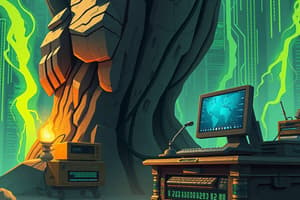Podcast
Questions and Answers
What is a key characteristic of a computer program?
What is a key characteristic of a computer program?
- It operates independently of any computer language.
- It requires the use of high-level programming languages only.
- It can be performed randomly without a structure.
- It consists of a sequential set of instructions. (correct)
Which of the following best describes programming?
Which of the following best describes programming?
- Simply writing machine code in binary form.
- Only creating websites using HTML.
- A process limited to data analysis tasks.
- The art and science of instructing computers using codes. (correct)
Which of the following is NOT a result of proficiency in programming?
Which of the following is NOT a result of proficiency in programming?
- Limited career opportunities. (correct)
- Improved logical reasoning skills.
- Enhanced problem-solving abilities.
- Capability to develop efficient algorithms.
What did the initial phase of programming involve?
What did the initial phase of programming involve?
Which programming characteristic facilitates breaking down complex tasks?
Which programming characteristic facilitates breaking down complex tasks?
Which programming paradigm emphasizes the sequence of steps to execute a program?
Which programming paradigm emphasizes the sequence of steps to execute a program?
What is a key characteristic of object-oriented programming?
What is a key characteristic of object-oriented programming?
Which of the following is an example of a functional programming language?
Which of the following is an example of a functional programming language?
What distinguishes low-level programming languages from high-level programming languages?
What distinguishes low-level programming languages from high-level programming languages?
Which of the following programming languages is primarily associated with object-oriented programming?
Which of the following programming languages is primarily associated with object-oriented programming?
What is the primary function of a compiler in programming?
What is the primary function of a compiler in programming?
Which of the following best describes the role of an interpreter?
Which of the following best describes the role of an interpreter?
In the context of problem-solving in programming, which step comes first?
In the context of problem-solving in programming, which step comes first?
What is the correct formula to calculate the volume of a rectangle?
What is the correct formula to calculate the volume of a rectangle?
During which step of programming is the algorithm implemented in a specific programming language?
During which step of programming is the algorithm implemented in a specific programming language?
What is the purpose of the Terminal symbol in a flowchart?
What is the purpose of the Terminal symbol in a flowchart?
Which symbol is used to represent any input/output operation in a flowchart?
Which symbol is used to represent any input/output operation in a flowchart?
What does the Flow line represent in a flowchart?
What does the Flow line represent in a flowchart?
Which symbol indicates that a decision must be made in the process?
Which symbol indicates that a decision must be made in the process?
What does the Predefined Processing symbol represent?
What does the Predefined Processing symbol represent?
What is a crucial requirement regarding the direction of flow in program flowcharts?
What is a crucial requirement regarding the direction of flow in program flowcharts?
Which of the following is true about the entry and exit points of flowchart symbols?
Which of the following is true about the entry and exit points of flowchart symbols?
What is the function of the Document Input/Output symbol?
What is the function of the Document Input/Output symbol?
What should the operations within flowchart symbols be independent of?
What should the operations within flowchart symbols be independent of?
Which connector is used to link parts of a flowchart that continue on the same page?
Which connector is used to link parts of a flowchart that continue on the same page?
Which symbol connects parts of a flowchart that are continued on separate pages?
Which symbol connects parts of a flowchart that are continued on separate pages?
Why is it important for decision branches in flowcharts to be well-labeled?
Why is it important for decision branches in flowcharts to be well-labeled?
Which of the following is NOT one of the five rules for creating program flowcharts?
Which of the following is NOT one of the five rules for creating program flowcharts?
Flashcards are hidden until you start studying
Study Notes
Programming Basics
- A computer program consists of sequential instructions, or codes, written in a computer language to perform specific tasks.
- Types of software include system software, web browsers, utility software, multimedia software, and spreadsheet software.
- Instructions must typically be executed in a defined sequence unless specified otherwise.
Programming
- Programming is the process of instructing computers using specific programming languages to create codes that solve problems and perform operations.
- Skills in programming are increasingly in demand across various industries, leading to diverse career opportunities including software development and data science.
- Programming enhances critical thinking, logical reasoning, and problem-solving skills essential for managing complex tasks.
Evolution and History of Programming
- Early programming involved writing machine code using binary instructions directly linked to computer hardware.
- The emergence of high-level programming languages simplified coding with more human-readable syntax.
- A wide ecosystem of programming languages and tools is available, each tailored to specific programming paradigms and application needs.
Programming Paradigms
- Procedural Programming: Organizes code into reusable procedures or functions; examples include BASIC, C, C++, Pascal, and Java.
- Object-oriented Programming (OOP): Centers around objects that encapsulate data and behavior; promotes modularity and reusability; examples include Python, VB.NET, and C#.
- Functional Programming: Focuses on computation as evaluating mathematical functions, emphasizing consistency and side effect avoidance.
Programming Languages
- Programming languages vary in syntax and specialization and can be categorized as:
- Low-level Languages: Closer to machine code and hardware.
- High-level Languages: More abstract and user-friendly than low-level languages.
Interpreters, Assemblers, and Compilers
- Interpreter: Executes high-level language instructions directly without conversion to machine language.
- Assembler: Converts low-level assembly code into relocatable machine language.
- Compiler: Transforms high-level languages into machine-readable code for execution by computers.
Algorithms, Pseudocode, and Flowcharts
- An algorithm is a structured set of steps leading to a solution for a specific problem, expressed in a natural language.
- Example algorithm to find the volume of a rectangle involves:
- Getting the length, width, and height.
- Calculating volume using the formula: volume = length × width × height.
- The problem-solving process consists of:
- Problem Analysis
- Algorithm Design
- Coding
- Execution
Flowchart Symbols
- Terminal: Represents the start and end of processes.
- Input/Output: Indicates input/output operations.
- Computer Processing: Shows processing performed by the system.
- Predefined Processing: Denotes any process not specifically defined in the flowchart.
- Comment: Used for explanatory statements.
- Flow Line: Connects flowchart symbols.
- Decision: Indicates points where decisions are needed.
- On-page/Off-page Connector: Connects parts of a flowchart within the same or different pages.
Flowchart Creation Rules
- Use only standard symbols.
- Show program logic flowing from top to bottom and/or left to right.
- Each symbol should have one entry and one exit point, except decision symbols, which can have multiple exits.
- Operations within symbols should be independent of programming languages.
- Decision branches must be clearly labeled.
Studying That Suits You
Use AI to generate personalized quizzes and flashcards to suit your learning preferences.




